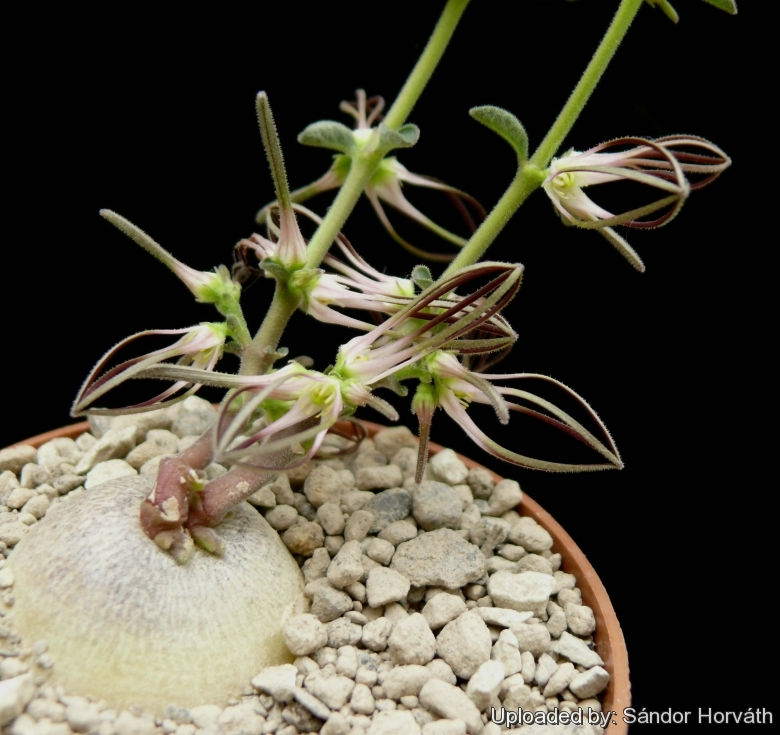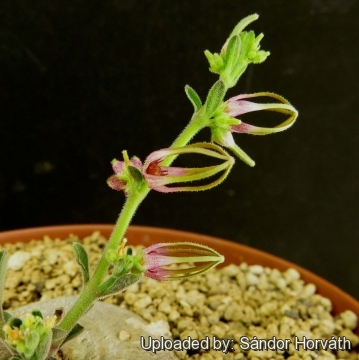
Brachystelma circinatum Photo by: Sándor Horváth
Origin and Habitat: Southern Africa - Namibia, Botswana, S. Africa (Eastern Cape, Free State, Gauteng, KwaZulu-Natal, Limpopo, Mpumalanga, Western Cape).
Altitude range: 500-1800 meters above sea level.
Habitat and ecology: Brachystelma circinatumSN|32283]]SN|32283]] grows in various stony places and has adapted to different environmental factors.
Synonyms:
See all synonyms of Brachystelma circinatum
back
Accepted name in llifle Database:Brachystelma circinatum E.Mey.Comm. Pl. Afr. Austr. (Meyer) 196 1838.Synonymy: 16
back
Common Names include:
ENGLISH: Bird-cage brachystelma
AFRIKAANS (Afrikaans): Wilde-aartappel
SOTHO (SOUTHERN) (seSotho): Bohobe-ba-setsomi
Description: Brachystelma circinatumSN|32283]]SN|32283]] is a dwarf perennial herb producing one or more stems that branch from the base 2 – 40 cm high, with a small flattish underground tuber (caudex), with its little lantern or cage-like flowers with no apparent corolla tube and long, narrow lobes remaining joined at their tips, it cannot be confused with any other species in south-west Africa. The leaves are sessile, opposite, oblong, soft and covered in whitish hairs. Leaves are ovate in shape with entire margins curled inwards and tapering apices. The flowers show a considerable variation in shape, size and colour with lobes from white to red-brown and from 5-25 mm in length. The vast amount of phenotypic variation has led N. E. Brov/n I.e. (1908) to the creation of several species, but it is very difficult to distinguish clearly between them, and a number of species originally in the genus Dichaelia are now part of the very broad, multiform Brachystelma circinatumSN|32283]]SN|32283]].
Tuber (caudex): Roundish, up to 100 mm diameter, flattish to depressed and often with slightly bowl-shaped central area.
Stems: Branches erect, solitary to several, umbranched to richly horizontally branched, densely puberulous with minute recurved hairs.
Leaves: (1) 2 (-few) at nodes, ascending or suberect from a spreading base, (2-)6-20(-40) mm long, linear or linear-subterete from being longitudinally folded or having incurved margins, acute or subobtuse, 8-12 mm broad when folded, puberulous like the stems or sometimes glabrous on upper surface, with the upper (infolded) surface glabrous.
Flowers: mostly in pairs at the nodes. Pedicels 2 (in fruit 4-5) mm long. Sepals about 1.5 mm long, lanceolate, acuminate, and like the pedicels minutely puberulous. Corolla from white to maroon, with cylindric beak in bud , 5-25 mm long, cage-like, lobed nearly to the base, with the lobes connate at the tips, minutely spreading-puberulous all over outside, glabrous within; united part flattish or saucer-shaped, scarcely 1.5 mm deep. Lobes 8-10 mm long, linear-filiform from a 1.5 -broad base. Outer corona-lobes shorter than the staminal column, about 0.5 mm long, deeply divided into 2 subulate slightly divergent teeth, glabrous, apparently whitish. Inner corona-lobes 0.25-05 mm long, half as long as the anthers and resting in a concave channel on their backs, with a small linear or subulate acute or obtuse point, and a rather thick dark-coloured fleshy dorsal gibbosity at their base.
Bibliography: Major references and further lectures
1) Christian Puff “Zur Biologie von Myrothamnus flabellifolius Welw., Myrothamnaceae” Verlag der S.W.A. Wiss. Ges., 1978
2) N. E. Brown “Flora Capensis”, Vol 4, 1909
3) Hyde, M.A., Wursten, B.T., Ballings, P. & Coates Palgrave, M. (2016). Flora of Zimbabwe: Species information: Brachystelma circinatum.
http://www.zimbabweflora.co.zw/speciesdata/species.php?species_id=146160, retrieved 10 January 2016
4) Leffers A. “Gemsbok Bean and Kalahari Truffle” Gamsberg MacMillan; Namibia. 2003
5) Useful Tropical Plants Database 2014 by Ken Fern, web interface by Ajna Fern with help from Richard Morris. “Brachystelma circinatum” <http://tropical.theferns.info/viewtropical.php?id=Brachystelma+circinatum> web 08 January 2016
6) Foden, W. & Potter, L. 2005. “Brachystelma circinatum E.Mey.” National Assessment: Red List of South African Plants version 2015.1. Accessed on 2016/01/10
7) Ralf Peckover “The cultivation of Brachystelma from seeds” ALOE 35 No.1, 1998
8) <http://www.flora-africa.com/The%20cultivation%20of%20Brachystelmas%20from%20seed.pdf> web 08 January 2016
9) R. A. Dyer “Notes on the Genus Brachystelma” Bothalia 10, 2 : 373-378
10) J.P. Roux “Flora of South Africa”, 2003
 Brachystelma circinatum Photo by: Sándor Horváth
Brachystelma circinatum Photo by: Sándor HorváthSend a photo of this plant.The gallery now contains thousands of pictures, however it is possible to do even more. We are, of course, seeking photos of species not yet shown in the gallery but not only that, we are also looking for better pictures than those already present.
Read More... Cultivation and Propagation: In cultivation the plants are usually grown in semi shade, with the tubers wholly or (preferably) partially exposed to prevent scorching and rotting of the roots. This plant can take a good deal of water during active growth and should be watered only when not dormant. Keep dryish in winter. It should be overwintered in the greenhouse at temperatures over 12°C (avoid letting temperatures drop lower than 5° C). Use a very draining but rich soil. An error in cultivation may produce unsightly holes in the tuber.
Traditional uses: The plant is harvested from the wild for local use of its edible root by South Sothos that call this plant “Bohobe-ba-setsomi” the bread (bohobe) of the hunter tubers
Reproduction: This species can be reproduced by seeds. Sow seeds in summer in a well drained medium.











